
Photo by Ryoji Iwata / Unsplash
Exploring the Paradox of Value
What is the Paradox of Value?
Diamonds command a higher price in the market as compared to water, when it is water without which human beings cannot live. This concept is called the paradox of value or the diamond-water paradox.
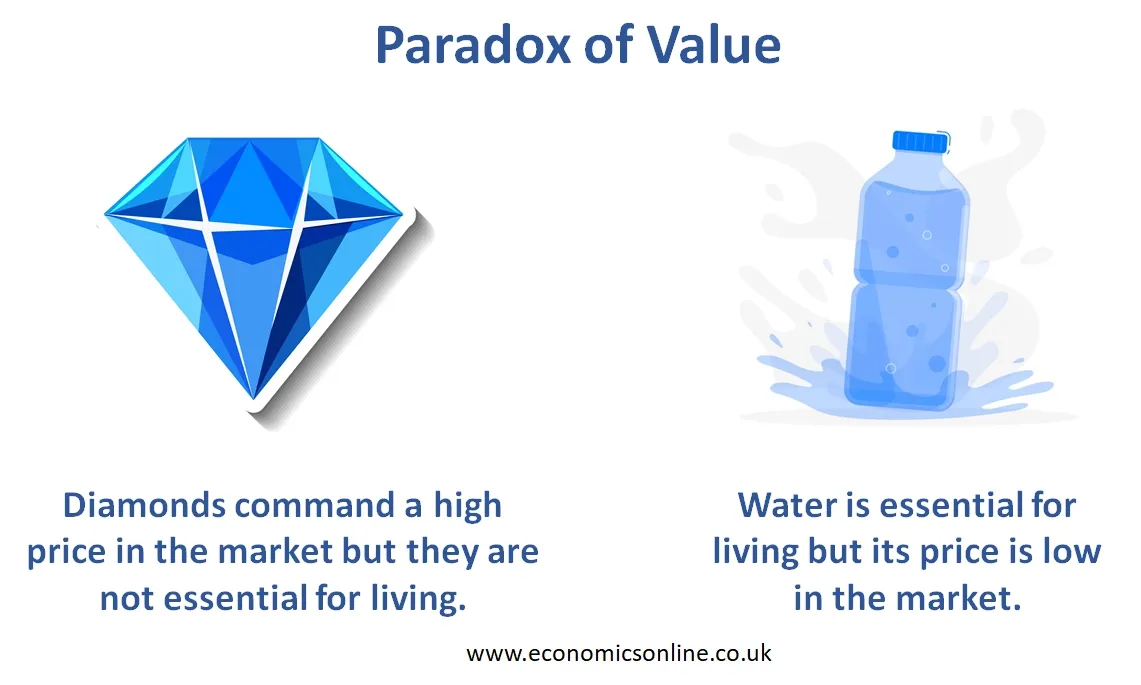
In economics, the observation about the diamond-water paradox describes that water is essential in terms of survival and has a low price in the market, whereas diamonds are not essential for survival but still have a high price in the market.
Understanding the Paradox of Value
This paradox of value can be logically explained with the help of the law of diminishing marginal utility. However, before explaining this law, let’s define some basic terms.
Utility
Utility refers to the satisfaction gained by a consumer from the consumption of a good.
Marginal Utility (MU)
Marginal utility refers to the additional satisfaction gained by a consumer from the consumption of an additional unit of a good.
Total Utility (TU)
Total utility refers to the total satisfaction gained by a consumer from the consumption of a given quantity of a good.
The Law of Diminishing Marginal Utility
This law states that by keeping other things constant, the marginal utility gained by a consumer decreases with an increase in the consumption of a good.
This law assumes that utility is cardinal (numerically measurable) and consumers are rational decision-makers.
According to this law, the price that a consumer is willing to pay depends on the marginal utility that the consumer is expecting to get from the consumption of a product.
A higher marginal utility means the consumer will be willing to pay a higher price.
A lower marginal utility means the consumer will be willing to pay a lower price.
Now consider the following graph:
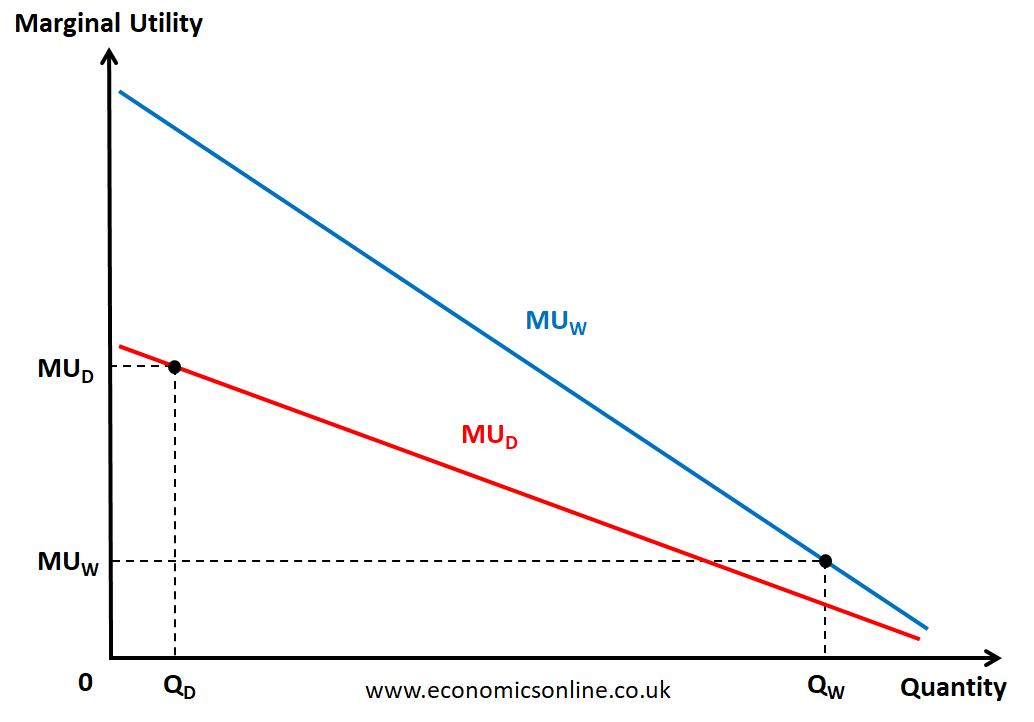
In the above graph, we have taken the quantity of diamonds and water on the horizontal axis (x-axis) and the prices of diamonds and water on the vertical axis (y-axis). The marginal utility curves for water and diamonds are MUW and MUD, respectively. Both of these curves are downward-sloping because of the law of diminishing marginal utility.
Explaining the Paradox of Value
In the above graph, QD shows the low quantity of diamonds that people can use due to the scarcity and rare availability of diamonds. Due to the low quantity of diamonds, their marginal utility (MUD) is high, and so is the price of diamonds.
On the contrary, QW shows the high quantity of water that people can use due to its abundant availability. Due to the high quantity of water, its marginal utility (MUW) is low, and so is the price of water. This explains the diamond-water paradox.
At low levels of consumption (QD), water has a much higher marginal utility than diamonds and thus is more valuable. However, people usually consume water at much higher levels than they do diamonds, and thus the marginal utility and price of water are lower than those of diamonds.
Consider a person standing in the hot desert with no access to water. In this case, the marginal utility of water becomes extremely high because it becomes necessary for your survival. But if the same person is in a city where the water is abundantly available, then the marginal utility of water is low due to its abundance.
Moreover, due to the rare nature of diamonds and their limited availability, they are highly valuable but not as necessary as water. As diamonds have a high market value, people around the world prefer to purchase diamonds because they depict a posh and luxury lifestyle.
Important Points
The following points also help to understand the paradox of value:
Subjective Value
The paradox arises because value is subjective. It depends on individual preferences and the scarcity of a particular item. Water is necessary for survival, but its abundance makes it less valuable in terms of exchange.
Utility vs. Scarcity
The value of a good is determined by both its utility (usefulness) and its scarcity. While water is highly useful, it is also abundant supply, making its marginal utility lower. On the other hand, diamonds are scarce goods, and this scarcity increases their perceived value.
Marginal Utility
The concept of marginal utility plays a role in the paradox. The utility of an additional unit of a good decreases as we consume more of it. There is a high total utility of water but a low marginal utility due to its abundance.
Social Constructs
The paradox of value also highlights the influence of social constructs and cultural factors on determining value. Society places a higher value on diamonds due to their rarity, aesthetic appeal, and symbolic significance.
Exchange Value
The paradox of value challenges the traditional theory of value based solely on usefulness. It emphasises that exchange value is determined by both subjective preferences and scarcity.
Factors affecting the Paradox of Value
The following factors affect the paradox of value, which are explained as follows:
Scarcity
Scarcity affects the paradox of value because when goods are less available or scarce in the marketplace, their value increases due to high demand.
Utility
The usefulness or utility of a good plays a role in determining its value. Goods that fulfil essential needs or provide significant benefits tend to have a higher value. The utility of some particular object is subjective and can vary from person to person.
Subjective Preferences
Individual preferences are subjective in nature. They tend to vary based on tastes and changing behaviours towards different products. Subjective preferences can also affect the value of goods because people prefer different levels of value for the same type of goods based on their personal liking or disliking.
Perceived Rarity
The perception of rarity, whether real or artificial, can impact the value of a good. If a good is perceived as rare or exclusive, its value may be higher.
Demand and Supply
The interaction between demand and supply affects the value of a good. If the demand for a good exceeds its supply, its value tends to increase.
Cultural Significance
The cultural significance or symbolic value associated with a good can impact its market price. Goods that hold cultural importance or are considered prestigious may have a higher price.
Market Conditions
Economic factors such as inflation, interest rates, and overall market conditions can influence the value of goods. These factors can impact consumer purchasing power and affect the perceived value of goods.
Branding and Marketing
The way a good is branded, marketed, and positioned in the market can influence its perceived value. Effective branding and marketing strategies can create a perception of higher value.
Emotional Factors
Emotional attachments, sentimental value, or personal significance associated with a good can impact its value. Goods that hold emotional value may be valued higher by individuals.
Time and Place
The value of a good can vary depending on the time and place. The values of seasonal goods vary based on the changing availability and demand during different times of the year.
Labour Theory of Value
An economic theory that tells us that the value of goods or services can be determined by the amount of labour needed to produce them is called the labour theory of value. The labor theory of value was explained by Adam Smith and Karl Marx. According to the labour theory of value, the higher the amount of labor, the more valuable the product is.
Subjective Theory of Value
The subjective theory of value states that the value of a good or service is determined by the subjective preferences and perceptions of individuals. In other words, value is not inherent in the good itself but rather is based on how much individuals desire or appreciate it. This theory was developed by economists such as Carl Menger and is a fundamental principle in understanding how prices are determined in a market economy.
Objective Theory of Value
An economic theory that says that the economic value of goods or services can be determined by objective factors such as the number of labourers, the amount of raw material, and the production costs needed to produce them is known as an objective theory of value. According to this theory, value is not solely based on individual preferences or perceptions but rather on measurable and tangible attributes. This theory has been associated with classical economists like Adam Smith and David Ricardo. It offers an alternative viewpoint to the subjective theory of value, which emphasises individual preferences.
Marginalism
Marginalism is a theory that focuses on the examination of decisions made at the margin, which means considering the additional or incremental changes in benefits and costs. It suggests that individuals make decisions by comparing the additional benefit they receive from consuming or producing one more unit of a good or service with the additional cost incurred. The marginalism theory was explained by economists such as William Stanley Jevons, Carl Menger, and Léon Walras. It has greatly influenced our understanding of consumer behaviour, production decisions, and resource allocation.
Supply of Diamonds and Water
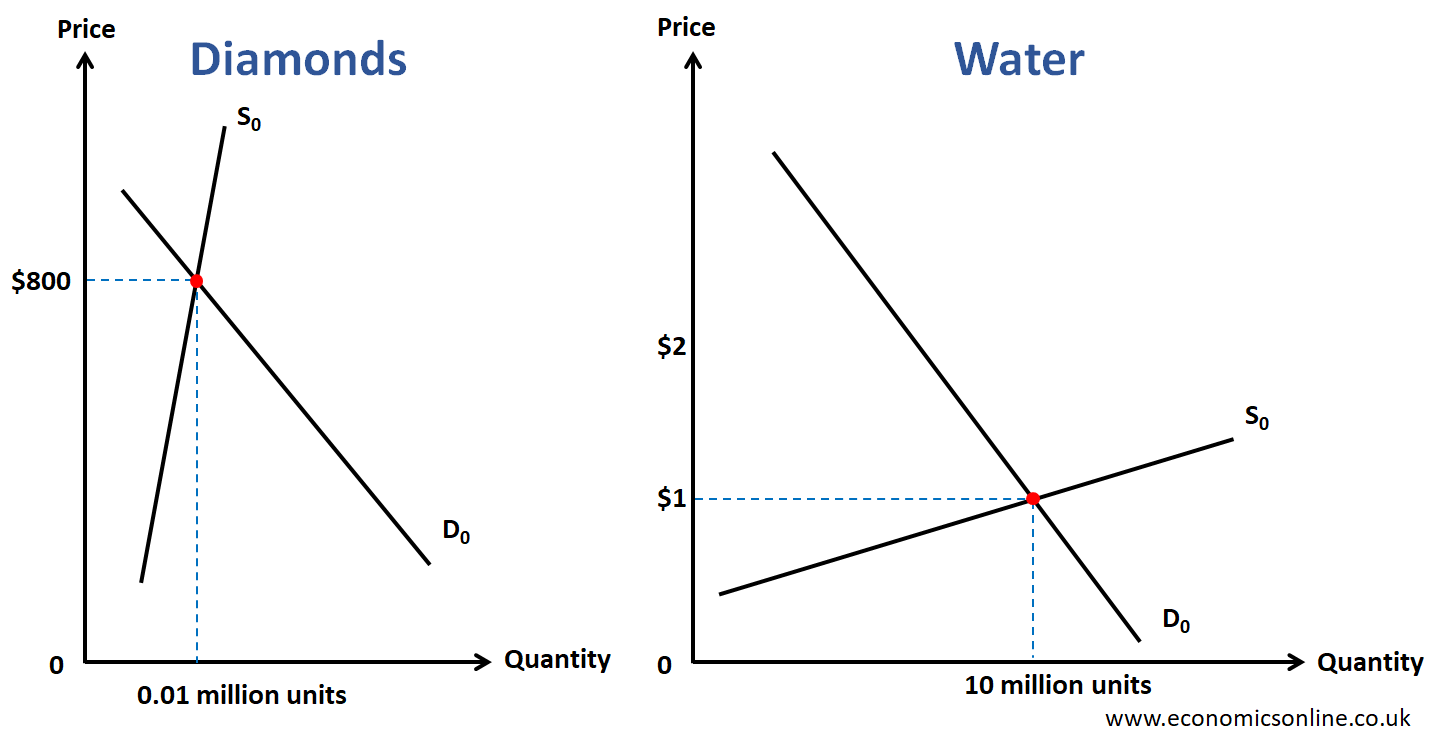
In the above graph, the markets for diamonds and water are illustrated. The graph on the left shows a price-inelastic supply of diamonds due to their scarcity and rare availability. The assumed price of a diamond is $800 at a quantity of 0.01 million units. This inelastic supply of diamonds is also a reason for their high prices.
The graph on the right shows a price-elastic supply of water due to its easy and abundant availability. The assumed price of water is $1 at a quantity of 10 million units. This elastic supply of water is also a reason for its low price in the market.
Diamond as a Veblen Good
Veblen goods are bought for show-off purposes or as status symbols. Diamonds are Veblen goods because they depict the posh and luxurious lifestyle of the elite class owning them. People with high incomes prefer to buy diamonds as luxury goods and as a symbol of their rich status and upper class.
Veblen goods are the exceptions to the law of demand, as their demand curve is upward-sloping. A price increase will increase the quantity demanded of Veblen goods, as shown below.
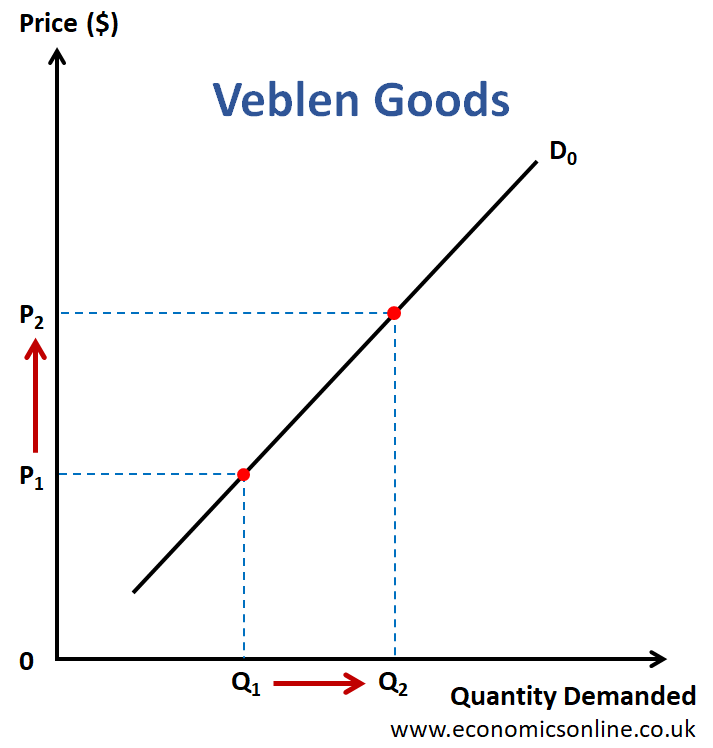
Marginal Utility vs. Total Utility
The following table contains the main points of difference between marginal utility and total utility, which helps in understanding the law of diminishing marginal utility and the water-diamonds paradox.
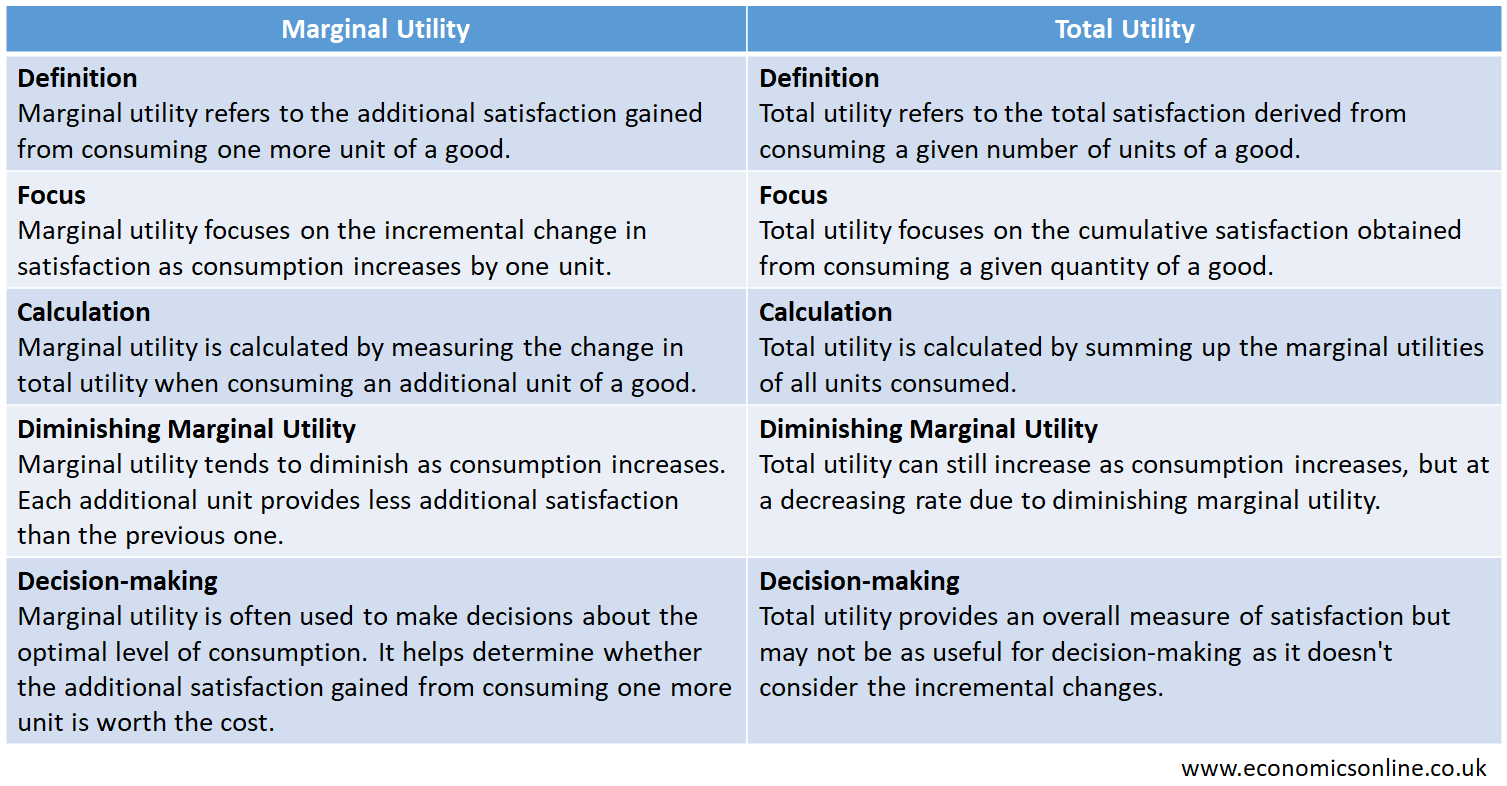
Conclusion
In conclusion, the paradox of value describes that luxury items and non-essential goods like diamonds have a higher price in the market as compared to water which is essential for living in daily life. The interpretation of the paradox of value can be done with the help of the theory of marginal utility. Many factors, such as demand and supply, the utility of goods, and the availability of these goods, affect their prices in the market.


